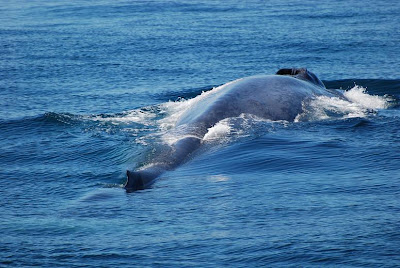
My parents and I took a quick trip up to Humboldt County, California, this weekend. Humboldt County is right on the Pacific Coast in extreme northern California - it is within a hundred miles of Oregon. The main purpose of the trip was to visit Humboldt State University in Arcata, a college I am considering. Naturally, I hauled my optics along, and spent a good amount of time birding.
We landed in the tiny Arcata Airport late on Thursday night and immediately collapsed into bed upon arriving at our hotel. We spent most of Friday touring Humboldt State University, poking around the campus and gathering as much information as possible. Even though we weren't birding, I identified Chestnut-backed Chickadees, Golden-crowned Kinglets, and Townsend's Warblers. Late in the afternoon, instead of relaxing in the hotel, I struck out on foot to bird the vicinity of the hotel.
Most hotels aren't great birding spots, and the Comfort Inn in Arcata wasn't an exception to this rule. However, there was a brushy area near the parking lot where I found Fox Sparrows, Orange-crowned Warblers, Cedar Waxwings, and a few other species. I went beyond the hotel, checking out some nearby vacant lots. Song Sparrows were everywhere - they seemed darker up there than in Southern California.

I walked around a bit longer, dodging some rather rough-looking homeless guys and their fierce mutts. I heard Chestnut-backed Chickadees calling from a few stunted evergreen trees in another vacant lot, and got good looks at one sitting out in the open. Unfortunately, there wasn't enough light to capture a good image of this incredibly cute bird.

Early on Saturday morning, the sleek-sided alarm clock on the nightstand beside my hotel bed demanded that we wake up. We departed before dawn and headed north to bird Prairie Creek Redwoods State Park. We arrived just after dawn. While driving in, several Roosevelt Elk were loitering by the roadside, but it was too dim for photography. We then headed deep into the redwood forest on a rough forest road, putting our little rental Mazda to the test. The trees were awesome, reaching sky-high with their crowns concealed in clouds of fog.

Birds were scarce among these giants, surprisingly. One would think that an old-growth rain forest with jumbo-sized trees would be chock-full of birds, but I only saw a few Steller's Jays, Chestnut-backed Chickadees, and Winter Wrens. At the end of the forest road, I could hear a few Varied Thrushes whistling eerily in the distance. They remained out of sight, much to my frustration - I needed it for my life list. As we were zipping back to the main highway, three Varied Thrushes flushed out of the middle of the road. We stopped, and they came back out into the open. We enjoyed great views as they hopped about on the carpet of dead needles. These gorgeous thrushes are superficially similar to American Robins, but are much more strikingly marked.

My other big target bird in Prairie Creek Redwoods State Park was American Dipper. The place to look for these guys is around the parking lot of Big Tree right off the scenic parkway. We headed down the wrong trail at first, but were rewarded with a little group of Gray Jays. Eventually, we got on the right trail and found the creek, but not the dippers.
Dippers are bizarre birds - an aquatic songbird. Dumpy gray birds that haunt the edges of creeks and rivers like fleeting shadows, they seem most like a combination of a robin, a sandpiper, and a duck. We strolled along the Prairie Creek a short distance, and as I rounded a bend, there was an American Dipper floating in the middle of the creek! As soon as it noticed me, it buzzed under cover at the creek's edge. After a few minutes of waiting, it popped back out and put on a great show by wading and swimming in the shallow creek. It was too far for good photos, and the light was bad, so as a result the photo I got of it was baaaad. But hey, it's a dipper, and a life bird for me!

Satisfied, we left the park and cruised south along the coast. We poked around a few beaches and lagoons, finding birds such as White-winged Scoter, Red-throated Loon, Common Murre, Common Merganser, and Belted Kingfisher. Our next major stop was Patrick's Point State Park, a great little park several miles north of Trinidad. A short walk from the parking area led to a spectacular overlook of rocky cliffs and the Pacific Ocean.

Ah, the birds. First, I noticed this little guy nosing around in the rocks at my feet.

Wait - not a bird, but a California Ground Squirrel. Actual birds I saw from the overlook included Black Oystercatcher, Surf Scoter, Common Murre, Pacific Loon, and Pelagic Cormorant. It was a very scenic spot - I took lots of photos!

After a delicious lunch at a charming little eatery in Trinidad, we headed back to Arcata. I was looking forward to birding Arcata Marsh, a famous wetlands right in Arcata that is good for shorebirds, ducks, and many other birds. Unfortunately, we must have hit it at the wrong time of day (afternoon), because not many birds were out. The sun finally broke through the persistent fog, and a few butterflies appeared out of nowhere, including this Mylitta Crescent. I was surprised they could still survive - in the morning it was in the low fifties.

By this time, I had utterly worn my parents out, and they insisted on returning to the hotel. We ate a meager dinner in the room and turned in early, since our flight home left at six this morning. Ouch, now that's an early start.
It was a fun weekend jaunt. It was great to gather more information about Humboldt State University - it seems very promising, and the birding in the area can't be beaten! I recorded about ninety species in our brief stay, including two lifers (Varied Thrush and American Dipper), and several other state birds. It was also enjoyable to get away from the craziness of Orange County and LA to this tranquil and sparsely-populated corner of the state.





















